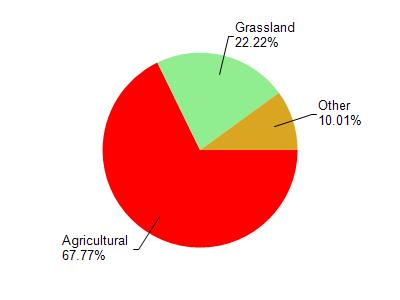Green
No
No
No
Fish and Aquatic Life
Overview
Basin Plan Whitehead Creek is a small stream that joins Honey Creek. The stream is managed as a warm water forage fishery but has not been monitored in the last 10 years. It continues to be impaired by agricultural non-point source pollution and ditching.
Date 2002
Author Aquatic Biologist
Historical Description
Bush, D.M., R. Cornelius, D. Engle, and C.L. Brynildson. 1980. Lake and Stream Classification Project. Surface Water Resources of Green County, 2nd Edition. Wisconsin Department of Natural Resources, Madison, Wisconsin.
This very small. warmwater stream flows southwest and joins Honey Creek. It runs primarily through pasture and suffers severe bank erosion. In addition. a large portion of the stream has been ditched. Silt and muck make up 70 percent of the bottom with the remaining 30 percent being gravel. The water is turbid.
The fishery of Whitehead Creek is comprised entirely of forage species. and wildlife values are minimal. Public access consists of two public road crossings.
Fish Species: Common shiner, bigmouth shiner, creek chub, white sucker.
Surface Acres = 1.7, Length = 3.5 Miles, Gradient = 34 ft./mi., Base Discharge = 0.8 cu. ft./sec
Date 1980
Author Surface Water Inventory Of Wisconsin
Condition
Wisconsin has over 84,000 miles of streams, 15,000 lakes and milllions of acres of wetlands. Assessing the condition of this vast amount of water is challenging. The state's water monitoring program uses a media-based, cross-program approach to analyze water condition. An updated monitoring strategy (2015-2020) is now available. Compliance with Clean Water Act fishable, swimmable standards are located in the Executive Summary of Water Condition in 2018. See also the 'monitoring and projects' tab.
Management Goals
Wisconsin's Water Quality Standards provide qualitative and quantitative goals for waters that are protective of Fishable, Swimmable conditions [Learn more]. Waters that do not meet water quality standards are considered impaired and restoration actions are planned and carried out until the water is once again fishable and swimmable
Management goals can include creation or implementation of a Total Maximum Daily Load analysis, a Nine Key Element Plan, or other restoration work, education and outreach and more. If specific recommendations exist for this water, they will be displayed below online.
Monitoring
Monitoring the condition of a river, stream, or lake includes gathering physical, chemical, biological, and habitat data. Comprehensive studies often gather all these parameters in great detail, while lighter assessment events will involve sampling physical, chemical and biological data such as macroinvertebrates. Aquatic macroinvertebrates and fish communities integrate watershed or catchment condition, providing great insight into overall ecosystem health. Chemical and habitat parameters tell researchers more about human induced problems including contaminated runoff, point source dischargers, or habitat issues that foster or limit the potential of aquatic communities to thrive in a given area. Wisconsin's Water Monitoring Strategy was recenty updated.
Grants and Management Projects
| Project Name (Click for Details) | Year Started |
|---|
|
|
Monitoring Projects
| WBIC | Official Waterbody Name | Station ID | Station Name | Earliest Fieldwork Date | Latest Fieldwork Date | View Station | View Data |
|---|
| 892600 | Whitehead Creek | 233095 | Whitehead Creek - A Tnrd Ab Honey Cr | 10/20/1987 | 7/21/2015 | Map | Data |
| 892600 | Whitehead Creek | 233094 | Whitehead Creek - Bl Whitehead Ch Co | | | Map | Data |
|

Watershed Characteristics
Whitehead Creek is located in the Honey and Richland Creeks watershed which is 80.09 mi². Land use in the watershed is primarily agricultural (67.70%), grassland (22.20%) and a mix of suburban (4.40%) and other uses (5.60%). This watershed has 195.33 stream miles, 16.47 lake acres and 117.89 wetland acres.
Nonpoint Source Characteristics
This watershed is ranked Medium for runoff impacts on streams, Not Ranked for runoff impacts on lakes and High for runoff impacts on groundwater and therefore has an overall rank of High. This value can be used in ranking the watershed or individual waterbodies for grant funding under state and county programs.However, all waters are affected by diffuse pollutant sources regardless of initial water quality. Applications for specific runoff projects under state or county grant programs may be pursued. For more information, go to surface water program grants.